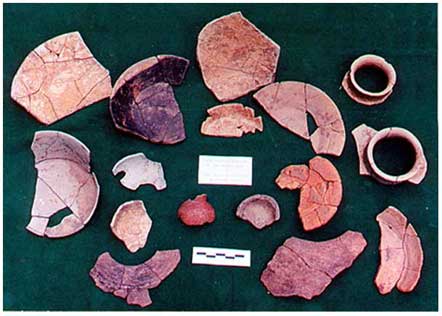
| FAMSI © 2000: Robert P. Kruger |
||
San Carlos Rural Olmec Household Project
Research Year: 1996 Table of Contents
Introduction The immediate purpose of this investigation was to collect data on the organization of a rural Early to Middle Formative domestic unit in the Olmec heartland of southern Veracruz, México. This site, designated RARO-154, was first located during my 1992 doctoral dissertation survey work (Kruger, 1996) on a large natural gravel elevation at the edge of the Coatzacoalcos River floodplain (Figure 1.1). It lies approximately halfway between the major Olmec center of San Lorenzo (Cyphers, ed. 1997) and the Olmec ritual offering site of El Manatí (Ortiz, Rodríguez and Delgado, 1997). A large paleochannel of the Coatzacoalcos River dating to before the end of the Early Formative period skirts the northern edge of this elevation, while a range of low dissected hills lies directly to the south. The site is within the limits of the community of San Carlos, municipality of Hidalgotitlán, on terrain used to graze cattle for the support of the community schools. At the time of discovery, much of the site area had been destroyed by modern gravel extraction (Figure 1.2). Occasional gravel extraction for the maintenance of the nearby road system continues to threaten portions of this and nearby occupation sites.
The site was originally identified when a large quantity of sherds and several features, including a large trash pit, caps of stone and burned clay, and what appeared to be several fire-pits were noticed eroding from the edge of a modern gravel pit (Figure 1.2, shown above). Recovered ceramics indicated an Early to Middle Formative date for these features. A second, much lighter distribution of material belonging to the Early Postclassic is also present on the western edge of the study area. The principal goals of this investigation were to examine a rural Olmec domestic unit in terms of: (1) the size and organization of the houselot; (2) the range of activities performed there, especially specialized activities; (3) subsistence data; and (4) its access to special and possibly controlled materials, such as obsidian and religious and/or ideological artifacts and symbols. With this and comparative data from households in other social and ecological situations in the region, we will be in a position to reconstruct the economic, social, and political systems that integrated this region during the crucial period of the Early Formative. To achieve these goals, investigations were conducted in four stages. First, the entire artifact-bearing section of the gravel-pit wall was cleaned, examined, and plotted, yielding a 53 meter long profile (Figure 2.1, Figure 2.2, Figure 2.3, Figure 2.4, Figure 2.5, and Figure 2.6). This gave us a good idea of the general stratigraphy and scale of the occupation. The second stage of investigation consisted of placing 167 10cm diameter auger probes in a grid of approximately 30 x 60 meters across the area adjacent to the gravel pit where the cultural features had been located (Figure 3). Probes were generally placed at five-meter intervals, while the center section of the test area was tested at 2.5 meter intervals to get finer-grained information of spatial distributions there. Third, three one by one meter test excavations were placed near features to be excavated in order to determine their limits and to study the stratigraphy. Finally, several features visible in the side wall of the gravel pit were excavated, and one test excavation was placed to examine the location of a subsurface probe that showed a high concentration of burned clay. The locations of these excavations are included in Figure 3. All of these investigations were tied into a central three dimensional coordinate grid. The zero point for all three dimensions is fixed by a cement-and-nail marker located at ground level on the floor of the modern gravel pit. Investigations revealed three distinguishable occupations at this site. The most recent occupation consisted of a concrete and tile house constructed on the western edge of the study area. According to local residents, this house was occupied several decades ago by members of a petroleum and sulfur exploratory team working in the area. Remains of cinder blocks and floor tiles are scattered in a circle of approximately 10 meter diameter, while excavation 5 also recovered some broken cement slabs. This occupation will not be further discussed in this report. Two prehispanic occupations were also uncovered: the lighter occupation yielded material dating to the Early Postclassic while the other dated to the Formative period. These last two occupations are the focus of this investigation. Click to download the report in PDF format: San Carlos Rural Olmec Household Project (1.84 MB) The PDF files require Adobe Acrobat Reader.
Submitted 09/01/1999 by: |
||
| Return to top of page | ||
|
Text links to all pages at this site are available at the FAMSI INDEX |
||


